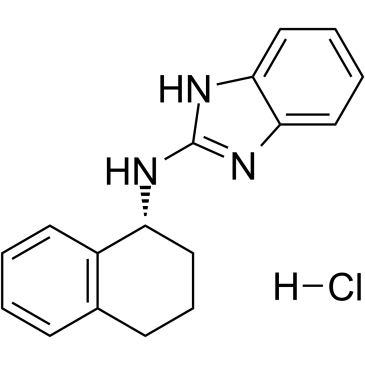| Cas No.: | 875755-24-1 |
| Chemical Name: | NS8593 hydrochloride |
| Synonyms: | NS8593; NS 8593; NS-8593; NS8593 HCl; NS8593HCl. |
| SMILES: | [H]Cl.C1(N[C@@H]2CCCC3=C2C=CC=C3)=NC4=CC=CC=C4N1 |
| Formula: | C17H18ClN3 |
| M.Wt: | 299.8 |
| Purity: | >98% |
| Sotrage: | 2 years -20°C Powder, 2 weeks 4°C in DMSO, 6 months -80°C in DMSO |
| Description: | NS8593 hydrochloride is a potent and selective small conductance Ca2+-activated K+ channels (SK channels) inhibitor. NS8593 hydrochloride reversibly inhibits SK3-mediated currents with a Kd value of 77 nM. NS8593 hydrochloride inhibits all the SK1-3 subtypes Ca2+-dependently (Kds of 0.42, 0.60, and 0.73 μM, respectively, at 0.5 μM Ca2+), and does not affect the Ca2+-activated K+ channels of intermediate and large conductance (hIK and hBK channels, respectively)[1][2]. |
| Target: | Kd: 0.42 μM (SK1), 0.60 μM (SK2) , and 0.73 μM (SK3)[2] |
| In Vivo: | NS8593 (compound 14) (3 and 10 mg/kg intravenously) is able to affect firing rate and firing pattern of dopaminergic neurons in vivo in C57Bl/6 mice[1]. |
| In Vitro: | When tested in excised patches, it is found that the inhibition by NS8593 (compound 14) decreased as the intracellular [Ca2+] is increased and that NS8593 is equipotent when applied from either the intracellular or the extracellular side of the cell membrane. A HEK293 cell transiently transfected with hSK3 channels is inhibited by 80% upon application of 100 nM apamin and by 75% after application of 300 nM NS8593. In contrast, NS8593 inhibits the mutated channel by 45% at 300 nM. NS8593 thus remains active on the apamin-insensitive SK3 channel, although the Kd value of 0.43 µM is 4-fold higher than found for a wild-type hSK3 channel (Kd of 0.10 µM). As the potency of NS8593 is dependent on the degree of SK3 channel activation, the decreased potency could thus reflect an increased apparent Ca2+-sensitivity of the mutated channels. Similar to the whole-cell experiments, the potency of NS8593 is reduced 3-fold from 0.67 µM to 2.2 µM when tested at a Ca2+ concentration of 500 nM[1]. |
| References: | [1]. Sørensen US, et al. Synthesis and structure-activity relationship studies of 2-(N-substituted)-aminobenzimidazoles as potent negative gating modulators ofsmall conductance Ca2+-activated K+ channels. J Med Chem. 2008 Dec 11;51(23):7625-34. [2]. Strøbaek D, et al. Inhibitory gating modulation of small conductance Ca2+-activated K+ channels by the synthetic compound (R)-N-(benzimidazol-2-yl)-1,2,3,4-tetrahydro-1-naphtylamine (NS8593) reduces afterhyperpolarizing current in hippocampal CA1 neurons. Mol Pharmacol. 2006 Nov;70(5):1771-82. |

 To enhance service speed and avoid tariff delays, we've opened a US warehouse. All US orders ship directly from our US facility.
To enhance service speed and avoid tariff delays, we've opened a US warehouse. All US orders ship directly from our US facility.




















